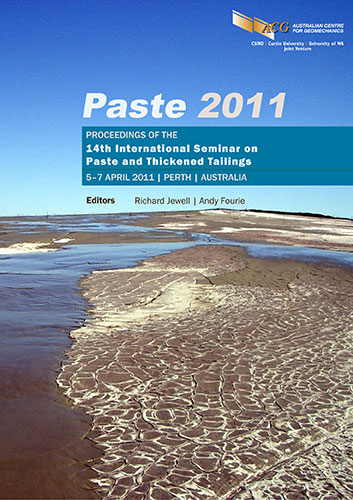Step change improvements in underflow rheology

|
Authors: Berger, A; Adkins, S; Hess, S; Flanagan, I; Stocks, P Paper is not available for download Contact Us |
DOI https://doi.org/10.36487/ACG_rep/1104_13_Adkins
Cite As:
Berger, A, Adkins, S, Hess, S, Flanagan, I & Stocks, P 2011, 'Step change improvements in underflow rheology', in R Jewell & AB Fourie (eds), Paste 2011: Proceedings of the 14th International Seminar on Paste and Thickened Tailings, Australian Centre for Geomechanics, Perth, pp. 135-141, https://doi.org/10.36487/ACG_rep/1104_13_Adkins
Abstract:
Many thickening operations continue to be constrained by their ability to process consolidated underflows with high yield stress and associated rheological characteristics. The application of high molecular weight polymers (flocculants) is a prerequisite to maintain the operation integrity and dynamics of most gravity based solids/liquid separation processes. Such treatments are an effective means of consolidating solids and maximising clean water recovery. Unfortunately polymer/solids interaction at, and beyond, the gel point result in a significant increase the yield stress for a given solids content. BASF is developing a novel flocculant treatment (NFT) by which primary solid/liquid separation efficiency is maintained, and the subsequent consolidation process is enhanced, wherein higher underflow solids are associated with reduced yield stress. This paper will present application data to demonstrate the benefits associated with this NFT.
References:
Barret, P. and Glennon, B. (1999) In-Line FBRM Monitoring of Particle Size in Dilute Agited Suspensions, Particle & Particle Systems Characterization, Vol. 16, pp. 207–221.
Boger, D.V. (1999) Rheology and the Minerals Industry, Mineral Processing and Extractive Metallurgy Review, Vol. 20, pp. 1–25.
Bremmell, K.E., de Kretser, R.G., Scales, P.J., Boger, D.V. and Healy, T.W. (2000) The Role of Coagulants and Flocculants in the Control of Compressional Dewatering of Mineral Slurries, in Proceedings XXI International Mineral Processing Congress, P. Massacci (ed), Elsevier, Amsterdam, Vol. A, pp. A5-30–A5-36.
de Kretser, R.G., Boger, D.V. and Scales, P.J. (2003) Compressive Rheology: An Overview, Rheology Reviews, Vol. 165, pp. 125–165.
Healy, T.W., Boger, D.V., White, L.R., Leong, Y.K. and Scales, P.J. (1994) Thickening and Clarification; How Much Do We Really Know About Dewatering?, in Proceedings Sixth AusIMM Extractive Metallurgy Conference, Brisbane, Australia, pp. 105–109.
Moody, G.M. and Norman, P.I. (2005) Chemical Pre-treatment in Solid/Liquid Separation: Scale-Up of Industrial Equipment, R.J. Wakeman and E.S. Tarleton (eds), Elsevier Advanced Technology, Oxford, pp. 38–81.
Scales, P.J., Healy, T.W. and Boger, D.V. (1998) Surfactants, Dispersants, Complexants and Flocculants – The Role of Additives in the Processing of Concentrated Particulate Suspensions in the Mining Industry, AusIMM 98 – The Mining Cycle, Mount Isa, Queensland, Australia, pp. 285–289.
Sofrá, F. and Boger, D.V. (2002) Environmental Rheology for Waste Minimisation in the Minerals Industry, Chemical Engineering Journal, Vol. 86, pp. 319–330.
Weiss, N.L. (1985) SME Mineral Processing Handbook, Society of Mining Engineers, New York, New York, 2,097 p.
Zhou, Z., Boger, D.V., Scales, P.J. and Healy, T.W. (1998) Shear and Compressional Rheology – Principles in Ceramic Processing, Surfactant Science Series, pp. 157–195.
© Copyright 2025, Australian Centre for Geomechanics (ACG), The University of Western Australia. All rights reserved.
View copyright/legal information
Please direct any queries or error reports to repository-acg@uwa.edu.au
View copyright/legal information
Please direct any queries or error reports to repository-acg@uwa.edu.au